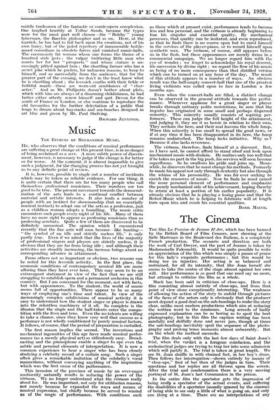The Cinema
THE film La Passion de Jeanne D'Arc, which has been banned by the' British Board of Film Censors, now showing at the Salle Marivaux in the Boulevard des Italiens, is a completely French production. The scenario and direction are both -the work of Carl Dreyer, and the part of Jeanne is taken by Mademoiselle Faleonetti. It would be quite possible to write an appreciation of the film which was simply a paean of praise for this lady's exquisite performance ; but this would be doing her an injustice. Her acting is so balanced and restrained, for all its intensity, that like Joan herself she seems to take the centre of the stage almost against her own will. Her performance is so good that one need say no more, but attempt to criticize the- film as a whole.
Much has been said in criticism of close-ups. Here is a film consisting almost entirely of close-ups, and from that point of view alone exceptionally interesting. The weakness of allowing the action of the story to unfold through pictures of the faces of the actors only is obviously that the producer must depend a good deal on the sub-headings to make the story clear, unlike most modern productions which aim at reducing the written word to the minimum. Long screeds of badly expressed explanation can be so boring as to spoil the best photography, but in this film the caption writing has been carefully and skilfully done and never jars, though at times the sub-headings inevitably spoil the sequence of the photo- graphy and prolong tense moments almost unbearably. But on the whole the method succeeds.
The film deals only with the last few days of Saint Joan's trial, when the verdict is a foregone conclusion, and the ecclesiastical judges are trying to trap her into some admission which will justify it. The trial is taken at great length. We see St. Joan shuffle in with chained feet, in her boy's dress. Then follows her interrogation—shown entirely by means of " close-ups," first of her then of the judges in turn. Their questions and her replies are all thrown upon the screen. After the trial and condemnation there is a very moving portrayal of St. Joan's last Communion in the prison.
In the entire film the spectator gets the impression of being really a spectator of the actual events, and suffering the disabilities of a spectator (usually ignored by the cinema) of being able to see only a little of what is going on, and only one thing at a time. There are no interpolations of any kind in the sequence of the action, no memories of Joan's past or visions -of 'What is happening in other parts of Fraifee, though these must have presented some temptation to the producer. The film is acted as though from the story of somebody in Rouen at the time, somebody who knew little of Joan's previous history, and little of the motives of the English verdict, but only saw her trial and murder on the spot and drew his own conclusions.
The film ends with the burning, taken completely realistic- ally. It is almost too painful to look at. It is an exceptionally interesting work both in the treatment of the story, which is simply and directly told in historical sequence, with the accuracy and singleness of vision of a child and in the technique of .the picture, which exploits all the most modern devices of lighting and unexpected angles of vision.
J. S.



















































 Previous page
Previous page